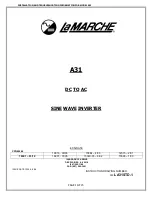
08
MECHANICAL INSTALLATION
Module Mounting
•
The LG Electronics’ (LGE) Limited Warranty for solar
modules is contingent upon modules being mounted
in accordance with the requirements described in this
section.
•
The solar modules are in Application Class A and
•
Use corrosion resistant material mounting rails and
hardware.
•
Use appropriate bolted connections as per
manufacturer’s instructions.
•
No electrical parts like cables are located after
installation between laminate and mounting structure.
•
LGE solar module is qualified up to a altitude of 4000m.
have the Safety Class II. Therefore they can be
operated in systems with 120V DC and higher.
General access is not restricted.
•
We recommend to use mounting device(bolt, nut,
washer) made by corrosion resistant material like
stainless steel.
Site Consideration
LGE solar modules should be mounted in a location that
meets the following requirements.
Operating Temperature
•
Maximum Operating Temperature: +90°C (194°F)
•
Minimum Operating Temperature: -40°C (-40°F)
•
Y is a safety factor of 1.5
•
Detail of mounting distance is below.
m
①
②
①
②
①
②
①
②
60Cell
①
: 200mm
72Cell
①
: 300mm
②
: 300mm
Module Strength(Basic Load) ; IEC61215-2:2016
m
Design Load : A
3600 Pascal
Front Side
Force
Direction
60Cell
Rear Side
2650 Pascal
5400 Pascal
4000 Pascal
3600 Pascal
Front Side
72Cell
Rear Side
2000 Pascal
5400 Pascal
3000 Pascal
Test Load : B
(B = A x Y )
Excluded Operating Environments
•
The solar modules from LG Electronics can not be
※
This mounting method is by using frame bolt holes.
※
The mounting rails must run perpendicularly to the module
long side.
operated in a location where they could come in direct
contact with salt water or ammonia.
Shadow
•
LGE solar module should be installed in a proper site
that there is no shadowing affected by building,
chimney, tree, and neighboring module, etc.
Mounting Methods
General Information
•
Select the appropriate orientation to maximize sunlight
exposure.
•
Module should not be mounted or stored in a way that
the front/top glass faces downward in order to prevent
water from entering the junction box, which could
cause a safety hazard.
•
Clearance between the solar module frames and
structures such as roofs or ground is required to
prevent wiring damage and to allow air to circulate
behind the solar module. The recommended standoff
height is a minimum of 100mm.
•
When installed on a roof, the solar module must be
is class C after ANSI/UL790 Edition 2004.
the application. The fire resistance of the solar module
mounted over a fire-resistant roof covering rated for
•
•
The solar module is only IEC listed for use when its
factory frame is fully intact.
•
Removal or alteration must be done by an authorized
and qualified individual.
•
Creating additional mounting holes may damage the
solar module and reduce the strength of the frame.
We recommend a 6mm gap between module frames
to avoid tension from thermal expansion.
Mounting
Rails
No. of Cell



































